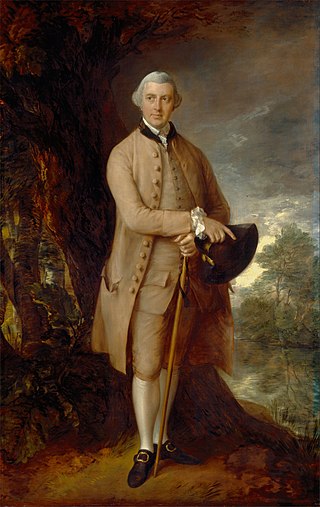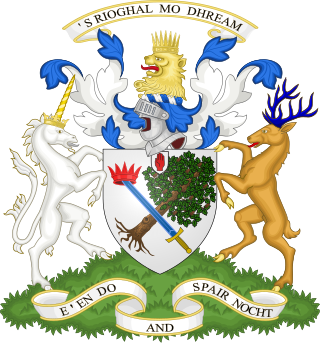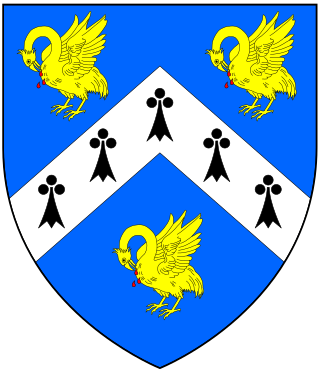Related Research Articles

Earl of Winchilsea is a title in the Peerage of England. It has been held by the Finch-Hatton family of Kent, and united with the title of Earl of Nottingham under a single holder since 1729.

Sir William Pulteney, 5th Baronet was a Scottish lawyer, Whig politician and landowner who sat in the British House of Commons between 1768 and 1805. One of the wealthiest Britons during his lifetime, he invested in the construction of several prominent buildings in Britain, including the Pulteney Bridge and other properties in Bath, Somerset, several beachfront residences in Weymouth, Dorset and roads in Scotland. Pulteney was also a patron of architect Robert Adam and civil engineer Thomas Telford. He also owned slave plantations in British America.
Princess Anne of Denmark was a first cousin of Elizabeth II and the mother of royal photographer Patrick Anson, 5th Earl of Lichfield and Lady Elizabeth Shakerley. She became a Princess of Denmark through her second marriage.

The Dalyell Baronetcy in the Baronetage of Nova Scotia was created 7 November 1685 for a Scottish General, Thomas Dalyell of the Binns. The succession of the title is unusual in that, in default of heirs male, it can pass by special remainder to tailzie succeeding him in the estate of The Binns.
There have been four baronetcies for persons with the surname Blake, one in the Baronetage of Ireland, two in the Baronetage of Great Britain and one in the Baronetage of the United Kingdom. Two of the creations are extant as of 2010. The Blake Baronetcy, of Menlough in the County of Galway, was created in the Baronetage of Ireland on 10 July 1622 for Valentine Blake, Mayor of Galway in 1611 and 1630 and a member of the Irish House of Commons for County Galway. His grandfather Thomas Blake had preceded him as Mayor. The second Baronet was a member of the Irish Parliament for Galway Borough. The third Baronet represented both County Galway and Galway Borough in Parliament. The sixth Baronet was a member of the Irish House of Commons for County Galway. He was the first Catholic gentlemen of distinction to join William of Orange. The twelfth Baronet represented Galway Borough in the British House of Commons. The fourteenth Baronet was high sheriff of County Galway in 1872. See also the Blake Baronetcy of Twizell Castle below.
There have been five Baronetcies created for people with the surname Forbes, four in the Baronetage of Nova Scotia and one in the Baronetage of the United Kingdom. The first holder of the Burn Baronetcy of Jessfield, created in the Baronetage of the United Kingdom in 1923, assumed the surname of Forbes-Leith of Fyvie in 1925.

The Gibson, later Gibson-Carmichael, later Gibson-Craig-Carmichael Baronetcy, of Keirhill in the County of Edinburgh, is a title in the Baronetage of Nova Scotia. It was created on 31 December 1702 for Thomas Gibson, with remainder to his heirs male. The sixth Baronet assumed the additional surname of Carmichael. The eleventh Baronet was a Liberal politician. In 1912, he created Baron Carmichael, of Skirling in the County of Peebles, in the Peerage of the United Kingdom. The barony died in 1926, while he was succeeded in the baronetcy by his kinsman Sir Henry Thomas Gibson-Craig-Carmichael, 5th Baronet, of Riccarton, who became the twelfth Baronet of Keirhill and assumed the additional surname of Carmichael.
The Buchan-Hepburn Baronetcy, of Smeaton-Hepburn in the County of Haddington, is a title in the Baronetage of the United Kingdom. It was created on 6 May 1815 for George Buchan-Hepburn. He was a Judge of the Admiralty Court from 1790 to 1791 and a Baron of the Exchequer for Scotland from 1791 to 1814. Born George Buchan, he assumed by Royal licence the additional surname of Hepburn in 1764, which was that of his maternal grandfather. His grandson, the third Baronet, represented Haddington in the House of Commons from 1838 to 1847. His son, the fourth Baronet, was a deputy lieutenant of Haddingtonshire. On the death of his grandson, the sixth Baronet, in 1992, the line of the eldest son of the second Baronet failed. The late Baronet, stepfather of the Duchess of Northumberland, was succeeded by his third cousin, the seventh and holder of the title. He was succeeded by his grandson in 2022. The family surname is pronounced "Bukkan-Hebburn".
There have been six baronetcies created for persons with the surname Thomas, three in the Baronetage of England, one in the Baronetage of Great Britain and two in the Baronetage of the United Kingdom. Two of the creations are extant as of 2016.

The Murray, later MacGregor of MacGregor Baronetcy, of Lanrick in the County of Perth, is a title in the Baronetage of Great Britain. It was created on 3 July 1795 for John Murray. He was a member of the Scottish MacGregor clan. This branch of the family had been forbidden to wear their own surname by King James VI, the only instance of this in British history. The ban was revoked in 1661 by King Charles II but restored during the reign of William and Mary. It was finally repealed in 1774. However, it was not until 1822 that the family obtained Royal licence to use the family surname. The second Baronet was a colonial administrator and served as Governor of Dominica, Antigua, Barbados and Trinidad. Sir Evan MacGregor, third son of the second Baronet, was Permanent Secretary to the Admiralty. The sixth Baronet was a Brigadier in the Scots Guards. The MacGregors of MacGregor are also the Chiefs of Clan Gregor.
There have been several Murray Baronetcies, all created in the Baronetage of Nova Scotia. Four of these baronetcies are extant.
There have been three baronetcies created for persons with the surname Wiseman, all in the Baronetage of England. Only one creation is extant as of 2008.
There have been seven baronetcies created for persons with the surname Sinclair, six in the Baronetage of Nova Scotia and one in the Baronetage of Great Britain. Four of the creations are extant as of 2008.

There have been four Baronetcies created for persons with the surname Johnston, two in the Baronetage of Nova Scotia, one in the Baronetage of Ireland and one in the Baronetage of the United Kingdom. One creation is extant as of 2010.
There have been five baronetcies created for persons with the surname Home, four in the Baronetage of Nova Scotia and one in the Baronetage of the United Kingdom. Only one creation is extant as of 2008.

There have been six baronetcies created for members of the Corbet family, four in the Baronetage of England, one in the Baronetage of Great Britain and one in the Baronetage of the United Kingdom. All creations are extinct. The recipients were descendants of the ancient Norman family of Corbet which held substantial estates in Shropshire including Wattlesborough, Caus Castle, Moreton Corbet Castle and Acton Reynald Hall.
Sir James Dalrymple, 2nd Baronet was Member of Parliament for Haddington Burghs and the Principal Auditor of the Exchequer in Scotland.

The Cullum baronetcy, of Hastede in Suffolk, was created in the Baronetage of England on 18 June 1660 for Thomas Cullum. It became extinct on the death of the eighth Baronet, 26 January 1855. The family estate was Hardwick House, Suffolk.
The Rivers, later Rivers-Gay, later Rivers Baronetcy, of Chafford in the County of Kent, was a title in the Baronetage of England. It was created on 19 July 1621 for John Rivers. He was a grandson of Sir John Rivers, Lord Mayor of London between 1573 and 1574. The sixth Baronet assumed the additional surname of Gay in circa 1760. This surname was also used by the seventh Baronet but not by any subsequent Baronets. The title became extinct on the death of the eleventh Baronet in 1870.
There have been four baronetcies created for persons with the surname Bennet, two in the Baronetage of England and two in the Baronetage of Nova Scotia. All four creations are extinct.